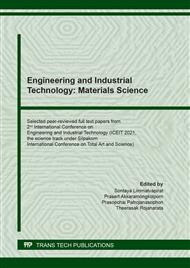p.93
p.99
p.105
p.111
p.117
p.123
p.129
p.135
p.141
Exposure Evaluation of Toxic Trace Elements in Thai Mulberry Leaves and Commercial Tea Infusion Products
Abstract:
Tea infusion is one of the most widely popular beverages. With several medicinal activities, mulberry leaf is listed as a raw material for tea infusion by the Thai Ministry of Public Health. However, long-term consumption may lead to health risk from toxic trace elements accumulated in herbal raw materials. In this research, the potentially toxic metal (including As, Cd, Pb, Ni and Ba) contents were determined in six mulberry reference leaves and nineteen commercial tea infusion products from local harvester (LHG) and non-harvester (non-LHG) groups using ICP-MS. Each sample was analyzed in triplicate. Health risks of toxic metal consumption was evaluated through content mean value, t-test and Pearson correlation at the significance level of 0.05. The relevant aspects of principal component analysis were also discussed. No observed contents of heavy metals in all sample exceeded the limitation of Thai FDA and WHO. Yet, it was notified that quantity of As, Cd, Ni and Ba in commercial products was higher than that of references while there was no difference in Pb content between two groups. Further investigation found that Cd, Ni and Ba contents in samples from LHG were lower than those from non-LHG significantly. On the contrary, higher Pb content was found in sample from LHG than that from non-LHG group. The amount of As was not different in both groups. As the result, awareness of environmental controls in cultivation area and proper production is crucial to reduce health risk of exposure to heavy metals.
Info:
Periodical:
Pages:
117-122
Citation:
Online since:
March 2022
Keywords:
Price:
Сopyright:
© 2022 Trans Tech Publications Ltd. All Rights Reserved
Share:
Citation:


